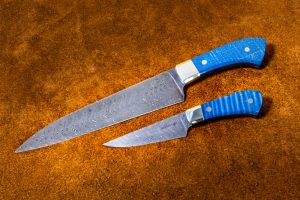Keeping Knives Sharp at Home Requires True Grit
By Micah Cheek
It’s scary to sharpen knives. Nobody wants to damage their knife, especially if it’s their new handmade santoku. For retailers selling fine cutlery, the sharpening process can be a great conversation starter and a way to offer customers the right sharpening tool for the particular knife.
 Steve Watkins, Knife Maker and Owner of Ironman Forge, says that a lot of sharpening difficulties come from the steel used to make the knife. If the steel is hard, it will hold an edge well, but the blade will be brittle. If the steel is soft, it will be flexible, but won’t hold an edge. “Most people’s frustration with sharpening knives is because the knives are heat-treated in a way that doesn’t hold an edge,” says Watkins. “In the 1950s, steel manufacturers started developing alloys. Once they developed hardenable stainless steel, the culinary industry thought, This will be a miracle steel because it won’t tarnish or rust… The alloys they use are not developed for knives. They lend themselves to tool manufacturing because they are wear resistant, but that makes it incredibly difficult to sharpen.”
Steve Watkins, Knife Maker and Owner of Ironman Forge, says that a lot of sharpening difficulties come from the steel used to make the knife. If the steel is hard, it will hold an edge well, but the blade will be brittle. If the steel is soft, it will be flexible, but won’t hold an edge. “Most people’s frustration with sharpening knives is because the knives are heat-treated in a way that doesn’t hold an edge,” says Watkins. “In the 1950s, steel manufacturers started developing alloys. Once they developed hardenable stainless steel, the culinary industry thought, This will be a miracle steel because it won’t tarnish or rust… The alloys they use are not developed for knives. They lend themselves to tool manufacturing because they are wear resistant, but that makes it incredibly difficult to sharpen.”
For chefs and experts, knives are sharpened according to their function. A Japanese Nakiri, for instance, is made of very hard steel and sharpened to a very fine edge to make quick work of soft vegetables, but has no place getting close to anything tougher to chop than squash. Other highly specialized knives will be crafted with different levels of flexibility, and require different sharpening regimens. But that level of expertise isn’t typical for home cooks, who generally want a dependable, all-purpose tool. Sharpening stones are the tool of choice, and come in a variety of coarse to fine grits. Consumers can even choose how to sharpen based on what they plan to cut. “I go from 600 to 1000 grit, 4000-5000 grit on the finish – that will be my last pass. Stones leave a tiny microscopic tooth on the edge. You want the teeth to grab a tomato skin and go through it,” says Watkins. “The only reason that I would hone higher would be if I had a specialty chef. If you were only going to cut meat or sashimi, I would take that even finer and finish it on a leather strop. It basically becomes a scalpel. Meat is sticky and will grab the edge, so you don’t need that tooth.”
“A lot of people will buy one knife that’s special to them that they will take really good care of. I will sharpen that so it will breast a turkey, dice, filet, whatever you need to do. So I’ll leave just a little bit of tooth on there,” Watkins adds.
The key to refining a cutting edge is simply practice. “Most people are going to struggle because they don’t know where to start. Go to a junk store and find any knife that has rust on it (carbon steel), and sharpen it,” says Watkins. “What you want to do is take strokes away from you, and you’re going to push against that stone. And you’re going to feel friction with that. If you’ve got the spine of the blade too close to the stone it will scratch, so you just lift the spine up enough that you’re not doing that anymore.” While there are a range of prices for sharpening sets, Watkins recommends focusing on the grit. “My stones just need to work, man. Simple, cheap stones are DMT Stones. They’re diamond-coated stainless steel. I have sharpened thousands of knives on mine,” Watkins adds. “You can use something like a Norton stone, which is 1000 on one side and 5000 on the other side. For my final cut, I’ve got a Norton and a Chinese 8000 grit stone.” But one thing that should never be used on a blade is a belt sander or grinder. Over time, electric sharpeners will start to reshape the blade itself. “From the heel of the knife towards the front of the blade, if you stick that flat on your cutting board, you don’t want to see daylight. That happens a lot when you sharpen with a belt,” says Watkins. “Here’s the thing: Never let someone sharpen your knives with a belt. You’ll take away too much steel.”
After sharpening, the edge can be checked in a couple different ways. “Take that knife and push it down your thumbnail. If it grabs at your thumbnail a little, it’s getting sharp. Once I know it’s sharp, I’ll take a piece of thin magazine paper and make a diagonal slice on it,” says Watkins. Simply using the succession of stones can get a knife sharp enough to shave with. “In my house, my knives are still shaving after about eight weeks,” says Watkins. “I will touch them up every eight weeks. I’ll put them on a fine stone for a few minutes. Typically I’ll fully sharpen a set once or twice a year.”

You must be logged in to post a comment.